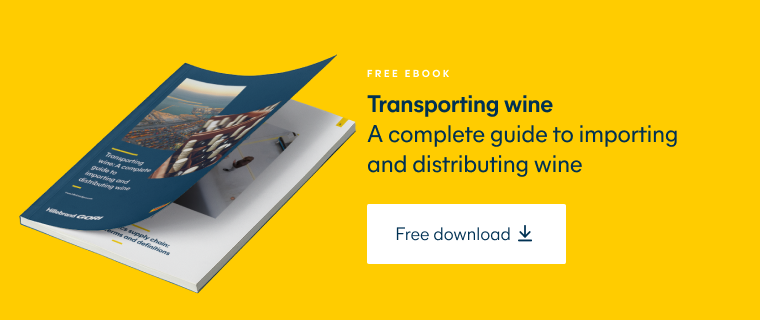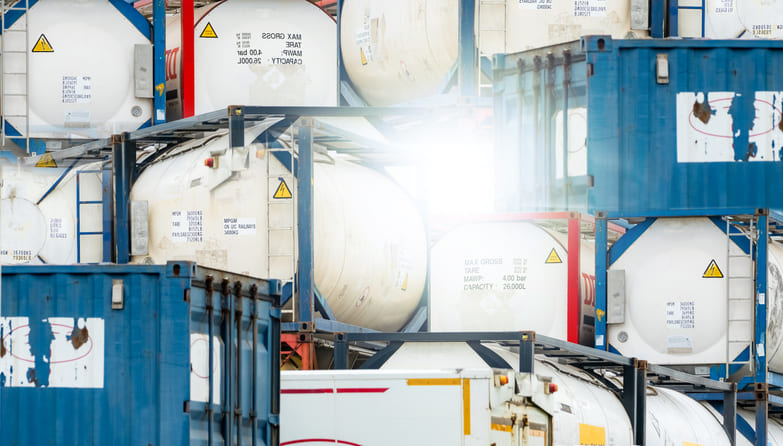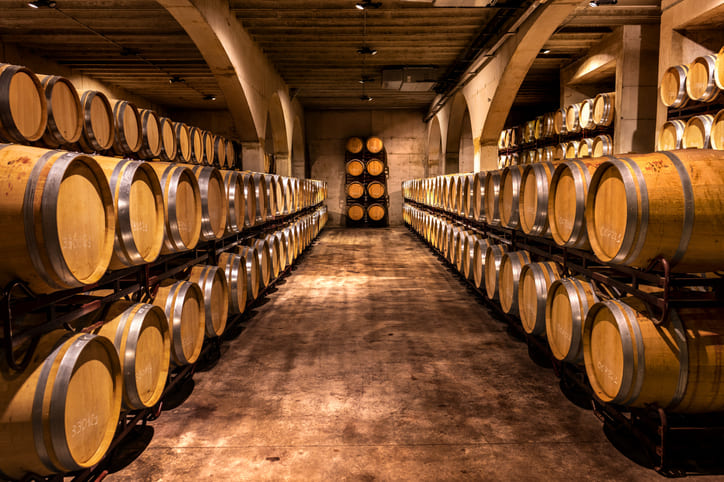Mastering multimodal transportation for wine importers
How you move your wine from the vineyards of Bordeaux or the Napa Valley to its destination can have a big impact on its quality. You want your wine to arrive in pristine condition, so transporting it requires a lot more than simply choosing the cheapest mode of transport or service option.
This is where multimodal transportation with a specialist beverage logistics provider can help. By combining various modes of transport by either land, sea or air, it offers wine importers versatile and cost-effective ways to make sure your wine arrives safely. But how do you zero in on your ideal transport mix?
Keep reading to learn everything you need to master the subject of multimodal transportation.
What does multimodal mean in transportation?
Most wine deliveries involve two or more different modes of transportation. Your wine will always start its journey on a truck, then switch to a train, plane, or ship — that's multimodal transportation.
The term has only really been in use since the late 1960s, but it’s been part of the wine trade for thousands of years. Picture an ancient Greek wine amphora delivered to a dock by mule and then loaded onto a boat, that’s also multimodal transportation.
Fast forward to today, and thanks to the variety of freight options available, multimodal transportation is your key to a flexible shipping solution.
How does multimodal transportation work?
The secret to the success of multimodal transportation and at the heart of it all is the humble shipping container.
To understand why shipping containers are so important, let’s look at the difference between the concepts of multimodal and intermodal transportation.
Multimodal transport refers to the entire process of moving beverages from origin to destination using multiple modes. A freight forwarder is responsible for the whole transportation chain and takes care of the logistics, coordination, and documentation.
Intermodal transport is the physical transfer of containers between different modes of transportation, at various points throughout a multimodal journey.
Modern shipping containers are designed to allow intermodal transport operations to be highly automatized.
Let’s take a look at how multimodal transportation typically works.
At the beginning of its journey, your wine is loaded into a shipping container that can be moved quickly and seamlessly from one mode of transport to another without being opened or unloaded. If you work with a freight forwarder like Hillebrand Gori, you can choose from dry containers, insulated containers, or refrigerated containers.
Once filled, the container is securely bolted and sealed, then taken by truck to a rail freight terminal or a shipping port where a crane transfers it onto a train or cargo ship for the next leg of its journey. Upon arrival, another crane unloads it for customs inspection or transfer to a truck or train that will haul its delivery point.
The whole process is fast, efficient, safe, and affordable. Typically it is facilitated by specialized infrastructure like intermodal terminals or ports. And watch this space, if Boeing’s plans for a plane that can pick up and carry shipping containers becomes a reality, the future of containers looks even brighter.
What are the most important factors of multimodal transport?
Of course, multimodal transportation involves more than just a game of pass-the-parcel with containers swapping between trucks, ships, trains, and planes.
This transport supply chain requires sophisticated logistics to make sure everything goes smoothly. The systems and personnel of the different companies involved need to be able to talk to each other and synchronize at all stages of the journey. A freight forwarder like Hillebrand Gori keeps the entire supply chain working in harmony and supports you throughout the process.
For example, with transportation management technology, such as the myHillebrandgori app, you're not just in the know, you're in control.
Use myHillebrandgori to:
- Keep track of your wine throughout its journey, no matter which form of multimodal transportation you choose.
- Connect with everyone involved in your wine’s journey and easily make contact with them.
- Instantly check order details like total packages, SKUs, and product codes.
- The myHillebrandgori app will give you real-time data with on-screen updates and push notifications letting you follow your shipments every step of the way and avoid delays or unnecessary costs.
Wine embarking on a global multimodal journey may take a trip through varying climates, even different seasons, causing fluctuations in temperature and humidity inside the container that can spoil your wine. So, the app can also show you the temperature at key points along the route. For peace of mind, you can even choose to add safeguarding measures such as a refrigerated container or a thermal insulation liner.
What are the types of multimodal transportation?
Road freight covers the first and last mile of every beverage shipment journey, but in between there may be several core modes of transport that you can choose from.
When you’re deciding which best suits your needs you need to take the following variables into account:
- Cost
- Speed
- Risk of damage or delay
- Carbon emissions
So how do the various transport options compare when it comes to these factors?
Road freight
Road freight is affordable and flexible and it’s the go-to transport mode for local and regional shipments. Trucks and vans deliver around 72.2% of the freight in the US and 76.7% of inland freight in Europe. Practically every destination where you would want to ship wine is accessible by road. To protect your wine, road freight can provide temperature-controlled solutions such as refrigerated vehicles or insulation liners for pallets and containers.
On the downside, road freight is responsible for 53% of all CO2 emissions from global trade transport, so it’s not the most eco-friendly option. Nor is it always cost-effective when it comes to long-distance shipments.
Sea Freight
Sea freight features heavily in multimodal transportation and moves about 90% of all globally traded goods.
Sea freight in general offers many advantages when moving wine from place to place.
The carrying capacity of container ships is immense. Extremely efficient economies of scale make it the most cost-effective way to move your beverages overseas, whatever the volume.
Containers ensure less handling during transit, reducing the risk of damage. It's also an environmentally friendly option and can help you shrink the carbon footprint of your business compared to air or road.
That said, sea freight is slower compared to air or even rail in some cases, and can be more vulnerable to delays.
Wine travelling by sea is also at risk of thermal shocks and humidity extremes. So it’s wise to invest in temperature-controlled or insulated containers to keep your wine in a stable environment and maintain its quality during transport.
Air freight
Air freight is fast and reliable, perfect for urgent or extra-sensitive wine shipments. It’s considered the safest method of transport, as airport terminals are highly secure spaces. It’s flexible enough to let you ship a few cases of wine or even entire plane loads up to 100 tons!
But it’s often the most expensive option and results in higher CO2e compared to other modes of transport.
Rail freight
Rail freight offers a lot when it comes to transporting wine overland, especially long distances. In terms of speed, trains have the edge over trucks because they don't get stuck in traffic, adhere to strict departure schedules and usually go direct to their destination. Plus, they're much friendlier on the environment and high security means theft from trains is rare.
FCL or LCL?
You can optimize your multimodal transportation strategy even further with Full Container Load (FCL) and Less than Container Load (LCL) services.
With FCL your wine will be the only product carried in your container on its journey. Loaded at the shipper’s warehouse and delivered straight to the receiver, FCL shipments are the best choice if you’re moving enough volume to fill an entire shipping container.
Choose LCL if the volume of wine you want to ship is small. Like one or a few pallets. Instead of waiting for enough orders to fill an entire container, your wine pallets can be consolidated into a shared container with other beverage pallets and you only pay for the space you use.
To protect your wine from damage and contaminating smells, freight forwarders like Hillebrand Gori offer a groupage service for LCL shipments. This means we only load your pallets with other beverage products at our warehouse. Then we ship the container to its destination, deconsolidate it and deliver your wine to you. Each leg of the transport can be made with temperature controlled equipment/facilities.
Full Truck Load (FTL) and Less than Truck Load (LTL) are similar services but for road freight.
What are the benefits of multimodal transportation?
A multimodal transportation strategy opens up a world of advantages compared to single mode transportation:
It’s cost effective
Choose from the whole array of transport modes and pick the most cost-effective solution for each leg of the journey. A truck might be essential for the beginning and end, but in the middle, it could be more economical to switch to a train or ship.
It’s optimizable
Optimize your route by using the fastest modes of transport for time critical deliveries.
It’s flexible
Plan a route that avoids extremes of temperature or humidity as much as possible or take measures to protect your wine on its journey.
It’s responsive
In the unlikely event of a delay or incident en route, switching modes of transport can be achieved with the help of your freight forwarder.
It’s greener
Multimodal transportation is also encouraged by international bodies such as the EU and the World Bank as a less polluting and more energy-efficient transport solution compared to using road freight alone. By using rail freight, sea freight or services like LCL and LTL, you can make your wine deliveries greener.
What’s the right multimodal transportation solution for you?
There’s no one-size-fits-all answer to choosing the best multimodal combination for your wine shipments, it depends on your unique needs.
By working with an experienced freight forwarder like Hillebrand Gori you can explore the full range of multimodal solutions and tailor your multimodal transportation strategy for each wine shipment.
Reach out to us to discuss how Hillebrand Gori can help to save you time and money and ensure your wine reaches you safely in top-quality condition.
How can we help your business grow?





